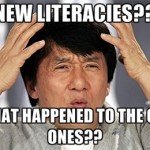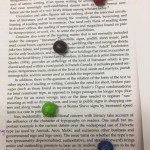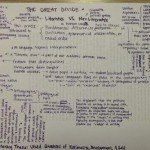
Brittany DeLacy: Dyson & Smitherman’s “The Right (Write) Start…”
In “The Right (Write) Start: African American Language and the Discourse of Sounding Right,” Anne Haas Dyson and Geneva Smitherman discuss how dialect, particularly African American Language (AAL), plays into a classroom where a standardized version of English is valued. Their outline of their research discusses their goals of the article and tells readers that they are questioning the system that is in place, while asserting that they understand students having an understanding of Language of Wider Communication (LWC).
Dyson and Smitherman present a case study of Tionna, a 6-year-old who has a good grasp of the language that her cultural dialect (AAL) values and this tends to transfer into her writing. When asked to write about why her teacher is the best, she has to meet with the student teacher to edit the piece. Or, as Tionna calls it, she has to do her “fix-its.” When the teacher stumbles into a sentence that does not follow her standardized version of English, she repeats Tionna’s writing back to her, “‘She is nice but if you be bad’ – let’s listen to how that sounds. Do you think that sounds right? ‘But if you be bad?’” (974). Since Tionna has grown up with sentence structures like “but if you be bad,” she does not understand that it needs to be corrected.
Dyson and Smitherman go on to point to the popular character Junie B. Jones. Junie B. Jones speaks in a way that “would fail to meet basic standards” (977) of standardized English based on her dialect in the Junie B. Jones novels. They point out that Junie B. Jones is seen as having “innocence and naivete” (977) based on her dialect, and show the discrepancy between this and an “at-risk” child like Tionna.
The research shows that children use the “voices of families, friends, media figures, and teachers” to “find their way into writing” (978). They argue that teachers need to have the understanding that students come from different cultural and dialectical backgrounds and that a mastery of “the so-called proper way [to speak] is not a precursor to learning to write” (978). Correcting a child will not help the student if they do not see the problem or if they do not have the problem in their dialect.
Although AAL is widespread across the globe, they give the example from Orlando Taylor where he shows that when “someone speaks with a French accent, it’s perceived to be very positive because the people are perceived positively . .The problem is that African American people and Black people around the world are perceived by dominant societies to be inferior, and so their language is perceived in a similar way” (980-981). They show that this mindset is contributing to students like Tionna being corrected for their dialect.
The article goes on to give more examples of how Tionna’s dialect was “fixed” in her writing, but Dyson and Smitherman show how it is correct in AAL. They point out that since Tionna’s teachers did not have an understanding of AAL, they were unable to help Tionna see the difference between dialect, instead just correcting her to their “right” way of speaking and writing.
When Anne Dyson went back to visit Tionna a year after their initial data collection, she brought a book that Tionna had loved called Three Wishes (990). This time, when Tionna read the book, she corrected all of the AAL examples from the book to be in the standardized version of English she had learned in school, adopting the idea that AAL was “wrong” or “incorrect.”
At the end of their article, Dyson and Smitherman argue that we need to value bilingualism and bidialectalism in the educational system. They argue that “the language(s) should be taught with a broad stroke, that is, including the culture, history, values, experiences, and sociopolitical realities of the speakers of the language(s)” (994) as a way to understand and engage in other cultures within the classroom.
In class, we looked at this piece in connection with Luis Moll and Norma González’s work with bilingualism in schools. We created posters that put these articles into conversation with each other. Both pieces valued cultural incorporation, social background, broad understandings of literacy practices, overcoming standardization present in traditional schooling, and embracing differences in the classroom. Although Smitherman and Dyson dealt more with bidialectalism, we agreed as a class that these were all important values for understand literacy across cultures.
Some questions that I still have after reading this piece are: how can we begin to incorporate a system that values bidialectalism? What kind of training can we implement for educators to have a better understanding of different dialects? What can we do to help children communicate across dialects while still being valued for their dialect?
Dyson, Anne Haas and Smitherman, Geneva. “The Right (Write) Start: African American Language and the Discourse of Sounding Right.” Teachers College Record, Vol. 111. 2009. 973-998.




